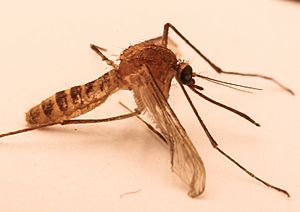London Underground mosquito facts for kids
Quick facts for kids London Underground mosquito |
|
|---|---|
 |
|
| Scientific classification | |
| Kingdom: | |
| Phylum: | |
| Class: | |
| Order: | |
| Family: | |
| Genus: | |
| Species: |
C. molestus
|
| Binomial name | |
| Culex molestus Forskal, 1775
|
|
The London Underground mosquito is a type of mosquito that belongs to the Culex group. As its name suggests, you can find it in the London Underground railway system. However, this mosquito actually lives all over the world and was around long before the London Underground even existed!
A scientist named Peter Forsskål first described this mosquito in Egypt in the late 1700s. He called it Culex molestus because it bit so much. Later, other scientists thought it was just a form of another common mosquito, Culex pipiens, because they looked very similar.
During World War II, when London was being bombed (this was called the Blitz), many people slept in the Underground stations for safety. These mosquitoes were known for biting the Londoners sheltering there.
Scientists have studied the DNA of this mosquito. In 2004, some research suggested that Culex molestus might be its own separate species. But a more recent study in 2012 said it's probably just a special type of Culex pipiens that has adapted to certain conditions.
Contents
About the London Underground Mosquito

Even though this mosquito was first found in Egypt, it has been discovered in underground systems all over the world. Some people thought it adapted to human-made underground places from local mosquitoes living above ground.
However, newer evidence suggests it's actually a type of mosquito from warmer, southern areas. It has adapted to live in the warm underground spaces of northern cities.
Scientists Kate Byrne and Richard Nichols found some interesting differences in how this mosquito behaves. They discovered that Culex molestus and the above-ground Culex pipiens act very differently. It's also very hard for them to mate with each other.
Here are some key differences:
- C. molestus breeds all year round.
- It doesn't like cold weather.
- It bites rats, mice, and humans.
In contrast, the above-ground C. pipiens:
- Sleeps through the winter (hibernates).
- Can handle cold weather.
- Mostly bites birds.
When scientists tried to breed the two types of mosquitoes together, their eggs didn't hatch. This suggests they are different enough that they can't easily have babies together.
How They Spread Around the World
Scientists have looked at the genes of molestus mosquitoes found in the London Underground. They found that these mosquitoes seem to come from a common ancestor. This means they didn't just adapt to the underground in each station separately.
At first, scientists thought that adapting to underground life was a rare event. They thought it might happen in different places around the world, with each local mosquito group evolving to live underground.
But more recent genetic studies show something different. It seems that a single type of C. molestus has spread across Europe and even further! Mosquitoes from far-apart places share very similar genes. This suggests that the underground form developed recently and then spread globally.
For example, underground mosquitoes in 10 different Russian cities share one small DNA difference. And a single DNA difference is found in mosquitoes across Europe, Japan, Australia, the Middle East, and the Atlantic islands.
How did they spread so far? It might have happened after the last ice age, or even more recently. One idea is that these mosquitoes hitched rides on international trade routes. For example, old tires that are shipped around the world can hold water. Mosquito larvae can survive in this water, making it easy for them to travel to new places.
Scientists also found that in America, a new type of Culex mosquito appeared. This type might have come from a rare successful mix between C. pipiens and C. molestus. This could explain why the American form bites both birds and humans. This is important because in 1999, the West Nile virus caused human illness in New York. This virus, which can be carried by mosquitoes, was new to the Western Hemisphere. In older populations, the above-ground C. pipiens usually bites only birds, while the human-biting ones are found underground.
Where They Live
The Culex molestus mosquito has been seen in North and South America, Europe, Asia, Africa, and Australia. It's believed to have originally come from Egypt. From there, it likely spread around the world through trade and travel over many centuries.
In the summer of 2011, many Culex molestus mosquitoes appeared in the Upper West Side of Manhattan, New York City. These mosquitoes are well known for living in New York's sewers and biting humans all year long. Residents of older buildings found the mosquitoes coming from underground into their basements and then into their homes through air vents. The city government didn't make this a top priority because the mosquitoes didn't carry the West Nile virus, and controlling them would be very expensive.
In Australia, Culex molestus was first recorded in the 1940s. Since then, it has spread across all the southern states, causing a lot of nuisance biting in cities. Unlike most city mosquitoes in Australia, molestus is active all 12 months of the year. It was probably brought to Australia during World War II through military movements into Melbourne. Genetic studies suggest it most likely came from eastern Asia and Japan. This mosquito has also been identified as a possible carrier for some Australian diseases that affect blood, like Ross River virus.
See also
 In Spanish: Mosquito del metro de Londres para niños
In Spanish: Mosquito del metro de Londres para niños

